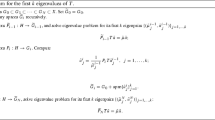Abstract
In this paper, we consider the numerical approximation of a biharmonic eigenvalue problem by introducing a new family of the mixed method. This method is based on a formulation where the fourth-order eigenproblem is recast as a system of four first-order equations. The optimal convergence rates with \(2k+2\) (\(k\ge 0\) is the degree of the polynomials) of eigenvalue approximation are theoretically derived and numerically verified. The optimal or sub-optimal convergences of the other unknowns are theoretically proved. The new numerical schemes based on the deduced problems can be of lower complicacy, and the framework is fit for various fourth-order eigenvalue problems.








Similar content being viewed by others
Data Availability
Enquiries about data availability should be directed to the authors.
Code Availability
The code can be made available on reasonable request.
References
Agmon, S., Douglis, A., Nirenberg, L.: Estimates near the boundary for solutions of elliptic partial differential equations satisfying general boundary conditions. I. Commun. Pure Appl. Math. 12, 623–727 (1959)
An, J., Li, H., Zhang, Z.: Spectral-Galerkin approximation and optimal error estimate for biharmonic eigenvalue problems in circular/spherical/elliptical domains. Numer. Algorithms 84(2), 427–455 (2020)
An, J., Luo, Z.: A high accuracy spectral method based on the min/max principle for biharmonic eigenvalue problems on a spherical domain. J. Math. Anal. Appl. 439(1), 385–395 (2016)
Andreev, A.B., Lazarov, R.D., Racheva, M.R.: Postprocessing and higher order convergence of the mixed finite element approximations of biharmonic eigenvalue problems. J. Comput. Appl. Math. 182(2), 333–349 (2005)
Antonietti, P.F., Buffa, A., Perugia, I.: Discontinuous Galerkin approximation of the Laplace eigenproblem. Comput. Methods Appl. Mech. Eng. 195(25–28), 3483–3503 (2006)
Babuška, I., Osborn, J.E.: Eigenvalue problems. In: Ciarlet, P.G., Lions, J.-L. (eds.) Handbook of Numerical Analysis, vol. 2. Elsevier Science B.V., North-Holland (1991)
Bauer, F.L., Fike, C.T.: Norms and exclusion theorems. Numer. Math. 2(1), 137–141 (1960)
Behrens, E.M., Guzmán, J.: A mixed method for the biharmonic problem based on a system of first-order equations. SIAM J. Numer. Anal. 49(2), 789–817 (2011)
Bermúdez, A., Durán, R., Muschietti, M., Rodríguez, R., Solomin, J.: Finite element vibration analysis of fluid-solid systems without spurious modes. SIAM J. Numer. Anal. 32(4), 1280–1295 (1995)
Bhattacharyya, P.K., Nataraj, N.: Isoparametric mixed finite element approximation of eigenvalues and eigenvectors of 4th order eigenvalue problems with variable coefficients. ESAIM Math. Model. Numer. Anal. 36(1), 1–32 (2002)
Brenner, S.C., Monk, P., Sun, J.: \(C^0\) interior penalty Galerkin method for biharmonic eigenvalue problems. In: Kirby, R.M., Berzins, M., Hesthaven, J.S. (eds.) Spectral and High Order Methods for Partial Differential Equations ICOSAHOM 2014, pp. 3–15. Springer International Publishing, Cham (2015)
Blum, H., Rannacher, R.: On the boundary value problem of the biharmonic operator on domains with angular corners. Math. Methods Appl. Sci. 2(4), 556–581 (1980)
Cakoni, F., Colton, D., Meng, S., Monk, P.: Stekloff eigenvalues in inverse scattering. SIAM J. Appl. Math. 76(4), 1737–1763 (2016)
Canuto, C.: Eigenvalue approximations by mixed methods. RAIRO Anal. Numér. 12(1), 27–50 (1978)
Carstensen, C., Gallistl, D.: Guaranteed lower eigenvalue bounds for the biharmonic equation. Numer. Math. 126(1), 33–51 (2014)
Chen, W., Lin, Q.: Asymptotic expansion and extrapolation for the eigenvalue approximation of the biharmonic eigenvalue problem by Ciarlet-Raviart scheme. Adv. Comput. Math. 27(1), 95–106 (2007)
Cockburn, B., Gopalakrishnan, J.: A characterization of hybridized mixed methods for second order elliptic problems. SIAM J. Numer. Anal. 42(1), 283–301 (2004)
Gallistl, D.: Morley finite element method for the eigenvalues of the biharmonic operator. IMA J. Numer. Anal. 35(4), 1779–1811 (2015)
Giani, S., Hall, E.J.C.: An a posteriori error estimator for hp-adaptive discontinuous Galerkin methods for elliptic eigenvalue problems. Math. Models Methods Appl. Sci. 22(10), 1250030 (2012)
Gopalakrishnan, J., Li, F., Nguyen, N.-C., Peraire, J.: Spectral approximations by the HDG method. Math. Comp. 84(293), 1037–1059 (2015)
Hecht, F.: New development in FreeFem++. J. Numer. Math. 20(3–4), 251–266 (2012)
Hu, J., Huang, Y., Lin, Q.: Lower bounds for eigenvalues of elliptic operators: by nonconforming finite element methods. J. Sci. Comput. 61(1), 196–221 (2014)
Ishihara, K.: A mixed finite element method for the biharmonic eigenvalue problems of plate bending. Publ. Res. Inst. Math. Sci. 14(2), 399–414 (1978)
Jia, S., Xie, H., Yin, X., Gao, S.: Approximation and eigenvalue extrapolation of biharmonic eigenvalue problem by nonconforming finite element methods. Numer. Methods Partial Differ. Equ. 24(2), 435–448 (2008)
Johnson, C.: On the convergence of a mixed finite element method for plate bending problems. Numer. Math. 21(1), 43–62 (1973)
Knyazev, A.V., Osborn, J.E.: New a priori FEM error estimates for eigenvalues. SIAM J. Numer. Anal. 43(6), 2647–2667 (2006)
Larson, M.G.: A posteriori and a priori error analysis for finite element approximations of self-adjoint elliptic eigenvalue problems. SIAM J. Numer. Anal. 38(2), 608–625 (2000)
Li, H., Yang, Y.: \(C^0\)IPG adaptive algorithms for the biharmonic eigenvalue problem. Numer. Algorithms 78(2), 553–567 (2018)
Lin, Q., Lin, J.: Finite Element Methods: Accuracy and Improvement. Science Press, Beijing (2006)
Lin, Q., Xie, H.: The asymptotic lower bounds of eigenvalue problems by nonconforming finite element methods. Math. Pract. Theory 42(11), 219–226 (2012)
Lin, Q., Xie, H., Xu, J.: Lower bounds of the discretization error for piecewise polynomials. Math. Comput. 83(285), 1–13 (2014)
Meng, J., Mei, L.: A \(C^0\) virtual element method for the biharmonic eigenvalue problem. Int. J. Comput. Math. 98(9), 1821–1833 (2021)
Meng, J., Mei, L.: The optimal order convergence for the lowest order mixed finite element method of the biharmonic eigenvalue problem. J. Comput. Appl. Math. 402(4), 113783 (2022)
Mercier, B., Osborn, J., Rappaz, J., Raviart, P.A.: Eigenvalue approximation by mixed and hybrid methods. Math. Comput. 36(154), 427–453 (1981)
Mora, D., Rodríguez, R.: A piecewise linear finite element method for the buckling and the vibration problems of thin plates. Math. Comp. 78(268), 1891–1917 (2009)
Rannacher, R.: Nonconforming finite element methods for eigenvalue problems in linear plate theory. Numer. Math. 33(1), 23–42 (1979)
Saad, Y., Chelikowsky, J.R., Shontz, S.M.: Numerical methods for electronic structure calculations of materials. SIAM Rev. 52(1), 3–54 (2010)
Timoshenko, S., Woinowsky-Krieger, S.: Theory of Plates and Shells, vol. 2. McGraw-Hill, New York (1959)
Wang, L., Xiong, C., Wu, H., Luo, F.: A priori and a posteriori error analysis for discontinuous Galerkin finite element approximations of biharmonic eigenvalue problems. Adv. Comput. Math 45(5), 2623–2646 (2019)
Yang, Y., Lin, Q., Bi, H., Li, Q.: Eigenvalue approximations from below using Morley elements. Adv. Comput. Math 36(3), 443–450 (2012)
Yang, Y., Han, J., Bi, H.: Non-conforming finite element methods for transmission eigenvalue problem. Comput. Methods Appl. Mech. Engrg. 307, 144–163 (2016)
Zhang, S., Xi, Y., Ji, X.: A multi-level mixed element method for the eigenvalue problem of biharmonic equation. J. Sci. Comput. 75(3), 1415–1444 (2018)
Zhang, Y., Bi, H., Yang, Y.: The two-grid discretization of Ciarlet–Raviart mixed method for biharmonic eigenvalue problems. Appl. Numer. Math. 138, 94–113 (2019)
Acknowledgements
The authors would like to thank both referees for their valuable comments and helpful suggestions which improved this paper.
Funding
The work of Y. Li was partially supported by the Scientific Research Plan of Tianjin Municipal Education Committee (2017KJ236), the Humanity and Social Science Youth Foundation of Ministry of Education of China (19YJC630199), and the National Natural Science Foundations of China (NSFC 12101447, 12271395). The work of M. Xie was partially supported by the National Natural Science Foundations of China (NSFC 12001402, 12071343, 12271400). The work of C. Xiong was partially supported by the Beijing Municipal Natural Science Foundation (BMNSF4182059) and the National Natural Science Foundations of China (NSFC 12271035).
Author information
Authors and Affiliations
Corresponding author
Ethics declarations
Conflict of interest
This work does not have any conflicts of interest.
Additional information
Publisher's Note
Springer Nature remains neutral with regard to jurisdictional claims in published maps and institutional affiliations.
Appendix: The proof of Lemma 3.1
Appendix: The proof of Lemma 3.1
In order to get the best possible estimates, we assume the following elliptic regularity result:
Then we have error equations as follows
for all \((v_h, \varvec{p}_h,\underline{\varvec{s}}_h,\varvec{m}_h) \in V_h\times \varvec{Q}_h\times \underline{\varvec{Z}}_h \times \varvec{W}_h \).
Now we begin to prove Lemma 3.1.
Proof
Using the dual equations (A.2) of the source problem (2.1), we have
We express the last term \((\varvec{q}^f-\varvec{q}^f_h,\varvec{\Pi }^Q_h\tilde{\varvec{w}})\). By the dual equation (3.8c), we have
Furthermore, using the integration by parts, we have
Next, we express the second term and the third term
The last term vanishes. In fact, it follows from \({\varvec{w}}^f_h-\varvec{\Pi }^{RT}{\varvec{w}}^f\in \varvec{Q}_h\cap \varvec{W}_h\) and \(\nabla \cdot ({\underline{\varvec{\Pi }}}^{RT}{\varvec{w}}^f-{\varvec{w}}^f_h) = 0\) that
by the integration by parts, \({{\tilde{u}}}|_{\partial \Omega }=0\) and (A.2d). Combining the all above steps implies the desired result. \(\square \)
Rights and permissions
Springer Nature or its licensor (e.g. a society or other partner) holds exclusive rights to this article under a publishing agreement with the author(s) or other rightsholder(s); author self-archiving of the accepted manuscript version of this article is solely governed by the terms of such publishing agreement and applicable law.
About this article
Cite this article
Li, Y., Xie, M. & Xiong, C. A New Family of Mixed Method for the Biharmonic Eigenvalue Problem Based on the First Order Equations of Hellan–Herrmann–Johnson Type. J Sci Comput 93, 66 (2022). https://doi.org/10.1007/s10915-022-02024-1
Received:
Revised:
Accepted:
Published:
DOI: https://doi.org/10.1007/s10915-022-02024-1




